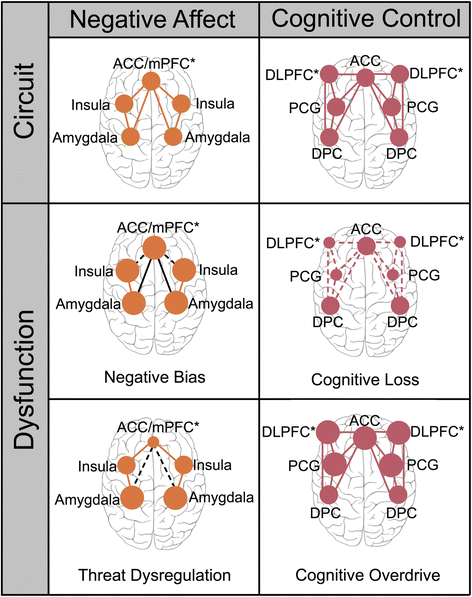Developing a clinical translational neuroscience taxonomy for anxiety and mood disorder: protocol for the baseline-follow up Research domain criteria Anxiety and Depression ("RAD") project
- PMID: 26980207
- PMCID: PMC4793523
- DOI: 10.1186/s12888-016-0771-3
Developing a clinical translational neuroscience taxonomy for anxiety and mood disorder: protocol for the baseline-follow up Research domain criteria Anxiety and Depression ("RAD") project
Abstract
Background: Understanding how brain circuit dysfunctions relate to specific symptoms offers promise for developing a brain-based taxonomy for classifying psychopathology, identifying targets for mechanistic studies and ultimately for guiding treatment choice. The goal of the Research Domain Criteria (RDoC) initiative of the National Institute of Mental Health is to accelerate the development of such neurobiological models of mental disorder independent of traditional diagnostic criteria. In our RDoC Anxiety and Depression ("RAD") project we focus trans-diagnostically on the spectrum of depression and anxiety psychopathology. Our aims are a) to use brain imaging to define cohesive dimensions defined by dysfunction of circuits involved in reactivity to and regulation of negatively valenced emotional stimulation and in cognitive control, b) to assess the relationships between these dimension and specific symptoms, behavioral performance and the real world capacity to function socially and at work and c) to assess the stability of brain-symptom-behavior-function relationships over time.
Methods and design: Here we present the protocol for the "RAD" project, one of the first RDoC studies to use brain circuit functioning to define new dimensions of psychopathology. The RAD project follows baseline-follow up design. In line with RDoC principles we use a strategy for recruiting all clients who "walk through the door" of a large community mental health clinic as well as the surrounding community. The clinic attends to a broad spectrum of anxiety and mood-related symptoms. Participants are unmedicated and studied at baseline using a standardized battery of functional brain imaging, structural brain imaging and behavioral probes that assay constructs of threat reactivity, threat regulation and cognitive control. The battery also includes self-report measures of anxiety and mood symptoms, and social and occupational functioning. After baseline assessments, therapists in the clinic apply treatment planning as usual. Follow-up assessments are undertaken at 3 months, to establish the reliability of brain-based subgroups over time and to assess whether these subgroups predict real-world functional capacity over time. First enrollment was August 2013, and is ongoing.
Discussion: This project is designed to advance knowledge toward a neural circuit taxonomy for mental disorder. Data will be shared via the RDoC database for dissemination to the scientific community. The clinical translational neuroscience goals of the project are to develop brain-behavior profile reports for each individual participant and to refine these reports with therapist feedback. Reporting of results is expected from December 2016 onward.
Trial registration: ClinicalTrials.gov Identifier: NCT02220309 . Registered: August 13, 2014.
Keywords: Anxiety; Brain circuits; Brain imaging; Cognition; Depression; Emotion; Research Domain Criteria (RDoC).
Figures
References
-
- Whiteford HA, Degenhardt L, Rehm J, Baxter AJ, Ferrari AJ, Erskine HE, Charlson FJ, Norman RE, Flaxman AD, Johns N, et al. Global burden of disease attributable to mental and substance use disorders: findings from the Global Burden of Disease Study 2010. Lancet. 2013;382(9904):1575–1586. doi: 10.1016/S0140-6736(13)61611-6. - DOI - PubMed
-
- American Psychiatric Association . Diagnostic and Statistical Manual of Mental Disorders: DSM-5. 5. Washington, D.C: American Psychiatric Association; 2013.
-
- Somers JM, Goldner EM, Waraich P, Hsu L. Prevalence and incidence studies of anxiety disorders: a systematic review of the literature. Can J Psychiatry. 2006;51(2):100–113. - PubMed
Publication types
MeSH terms
Associated data
Grants and funding
LinkOut - more resources
Full Text Sources
Other Literature Sources
Medical


